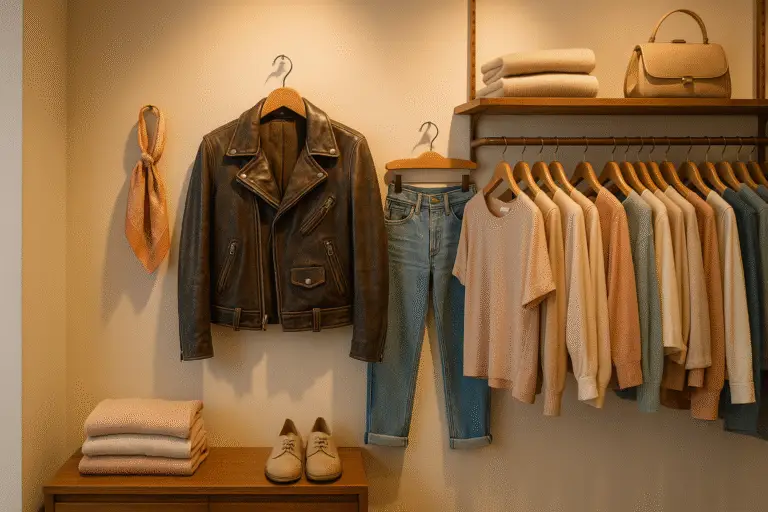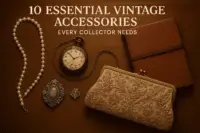Nostalgia is driving a shift in fashion. Vintage clothing, with its connection to past decades, is about emotion, memories, and individuality. From authentic vintage pieces to retro-inspired designs, this trend is reshaping how people shop, blending personal history with modern preferences. Here’s what you need to know:
- Why it matters: Vintage fashion connects buyers to the past, offering quality, timeless pieces in a world dominated by fast fashion.
- What drives it: Emotional ties, sustainability, and the desire for unique styles fuel the growing demand for vintage.
- Generational trends: Gen Z loves individuality and eco-conscious choices; Millennials seek nostalgia from their youth; Gen X values quality; Boomers appreciate the historical context.
- Mass-market vs. independent sellers: Big brands like Levi’s and Converse use their heritage to appeal to buyers, while small sellers offer rare, one-of-a-kind finds.
Whether it’s about sustainability, personal expression, or reconnecting with the past, vintage fashion continues to influence modern buying habits.
I Went Down the Vintage Fashion Rabbit Hole | BECOMING: A VINTAGE ENTHUSIAST
Psychology Behind Nostalgic Fashion Choices
Vintage fashion evokes emotions. Wearing vintage pieces often stirs up personal memories and connects us to a shared sense of history. This emotional pull can turn a simple shopping trip into something much more meaningful, as the memories tied to these garments add a layer of value beyond their physical appeal. This emotional connection plays a big role in why people choose to buy vintage.
How Nostalgia Influences Buying Decisions
What makes vintage so appealing is the way these pieces bring back personal memories. For many, choosing vintage is about reconnecting with moments from the past that feel special. This emotional bond often motivates buyers to seek out items that feel authentic and personally significant, making their purchases more than just transactions.
Bridging Past, Present, and Future Through Vintage
Vintage clothing acts as a bridge between different points in time. These garments invite wearers to reflect on their own journey. Whether it’s a dress from the 1950s or a jacket from the 1980s, each piece carries a story, connecting the wearer to both personal milestones and broader historical narratives.
Nostalgia as a Form of Personal Expression
The blend of memory and history gives vintage fashion a unique role in personal storytelling. When someone wears a vintage piece, they’re sharing a part of their life story. These items become personal artifacts, symbolizing where the wearer has been and how they’ve grown. This deeply personal connection is one of the reasons vintage fashion resonates with so many people and continues to thrive in the mainstream market.
How Mass-Market Vintage Brands Use Heritage
Mass-market brands have realized that their history can be a powerful tool. Instead of chasing every short-lived trend, many established companies are digging into their archives and using their past to craft marketing strategies that feel genuine. This approach is about tapping into the nostalgic feelings that often drive people to embrace vintage fashion. By leaning on their heritage, these brands create a sense of authenticity that helps them connect with consumers on a deeper level.
Heritage works because it tells a story. When customers buy from these brands, they’re buying into a legacy of craftsmanship, tradition, and meaning.
Examples of Mass-Market Vintage Brands
Several well-known brands showcase how effective this strategy can be:
- Levi’s: Known for its iconic denim, Levi’s has embraced its history with vintage-inspired collections that celebrate its legacy. The Levi’s Vintage Clothing line, for example, focuses on recreating classic designs with attention to period details and craftsmanship. These pieces often come at a premium price, emphasizing their connection to the brand’s storied past.
- Converse: The Chuck Taylor All Star, introduced in the early 20th century, remains at the heart of Converse’s identity. Now owned by Nike, the brand highlights its basketball roots and countercultural history while collaborating with artists to keep the classic silhouette fresh and relevant.
- Champion: Once known primarily for its athletic wear, Champion has reemerged as a streetwear favorite. By spotlighting its history as a supplier for universities and sports teams, the brand has repositioned its vintage-style sweatshirts and hoodies as must-have items.
- Red Wing Shoes: This brand has stayed true to its roots, producing boots with traditional construction methods that have stood the test of time. The Red Wing Heritage collection focuses on classic styles that remain largely unchanged, reinforcing the brand’s reputation for quality and durability.
These brands show how heritage can elevate products into timeless icons, creating a foundation for lasting customer loyalty.
Building Brand Loyalty Through Heritage
Heritage marketing builds emotional connections. By sharing their history, brands turn purchases into meaningful experiences.
A long-standing history inspires trust. A company that has been around for decades is often seen as reliable and consistent. If its products weren’t high-quality, it’s unlikely the brand would have survived. This reputation allows heritage brands to charge premium prices while keeping customers loyal, even when plenty of alternatives exist.
Storytelling is another key element. When brands share their past, they invite consumers to connect with their legacy, even if those consumers weren’t part of the original era. This ability to bridge generations explains why today’s shoppers are drawn to vintage-inspired designs.
Consistency also plays a big role. While many companies constantly change their look and messaging to keep up with trends, heritage brands stick to a recognizable aesthetic and core values. This steadiness makes them feel more dependable and authentic in a world where trends come and go.
Heritage brands also benefit from cross-generational appeal. Customers who loved these brands in their youth often introduce them to their children, creating a sense of tradition and organic word-of-mouth promotion that’s hard to replicate.
The secret to successful heritage marketing lies in balancing the old and the new. By respecting their history while staying relevant to modern tastes, these brands create a loyal customer base. The mix of storytelling, timeless design, and nostalgia ensures that their legacy continues to resonate with today’s buyers.
Consumer Behavior and Age Group Trends
Exploring how various age groups engage with vintage fashion reveals unique patterns in shopping habits, motivations, and their connection to nostalgia. Each generation interacts with vintage in its own way, shaping both the market and how brands position their heritage products. These generational preferences provide valuable insights into broader consumer behaviors and strategies within the vintage fashion industry.
How Different Generations Buy Vintage
Generation Z (born 1997-2012) approaches vintage fashion as a way to showcase individuality and break away from fast fashion norms. For them, it’s less about nostalgia and more about discovering one-of-a-kind pieces that make a statement. They’re known for blending authentic vintage with modern items, creating bold, eclectic styles that reflect their personalities. Sustainability also plays a big role. Vintage shopping aligns with their desire to make environmentally conscious choices.
Millennials (born 1981-1996) tend to have a more emotional connection to vintage. Many are drawn to styles from the 1990s and early 2000s, eras tied to their formative years. They often seek out specific brands or designs that evoke personal memories or align with their aesthetic preferences. Millennials are also more likely to research their purchases, focusing on authenticity and the stories behind the pieces they buy.
Generation X (born 1965-1980) gravitates toward vintage pieces from the 1970s and 1980s, reflecting the decades of their youth. For this group, vintage fashion often represents a return to the craftsmanship and quality they remember from earlier times. They’re willing to invest in high-quality vintage or heritage brand items, viewing them as timeless additions to their wardrobes rather than fleeting trends.
Baby Boomers (born 1946-1964) bring a unique perspective, having lived through many of the eras now considered vintage. They value the cultural context and historical significance of these pieces, often seeing vintage fashion as a way to reconnect with their past. Boomers also appreciate the quality and durability of older garments, which they often find superior to many modern options.
These generational differences highlight how vintage fashion continues to evolve, influenced by varied consumer relationships with style, nostalgia, and sustainability.
Why People Buy Vintage and What Stops Them
Vintage fashion appeals to shoppers for reasons beyond aesthetics. Many are drawn to its quality, durability, and craftsmanship – attributes often lacking in fast fashion. Vintage garments frequently feature superior materials and construction, making them long-lasting wardrobe staples.
Sustainability is another major motivator, especially among younger consumers. Buying vintage extends the life of existing clothing, reducing waste and the environmental impact of new production. This aligns with growing awareness of the fashion industry’s ecological footprint.
Affordability can also make vintage appealing. While some rare designer pieces fetch high prices, many vintage items offer better value compared to modern counterparts, particularly for those seeking unique or high-quality garments.
Individual expression is a key driver for many vintage shoppers. Vintage allows people to step away from mass-produced fashion and create looks that reflect their personal style.
However, not everyone embraces vintage shopping. Hygiene concerns are a common barrier, as some buyers worry about cleanliness despite reputable sellers ensuring items are properly cleaned. Sizing issues also deter shoppers, as vintage sizing often differs from modern standards, making it tricky to find the right fit, especially online.
Accessibility can be another challenge. Authentic vintage items are often limited to specialized stores, thrift shops, or online marketplaces, which may not be convenient for everyone. Finally, condition uncertainties, such as wear, defects, or the need for alterations, can add to the cost and complexity of buying vintage.
Mass-Market vs. Independent Vintage Sellers
Consumer preferences also shape how different sellers cater to the vintage market. The landscape includes both large heritage brands and smaller independent sellers, each offering distinct benefits and drawbacks.
| Aspect | Mass-Market Brands | Independent Vintage Sellers |
|---|---|---|
| Price Range | $50-$300+ for vintage-inspired pieces | $10-$500+ depending on rarity and condition |
| Authenticity | Reproductions with modern construction | Genuine vintage from original eras |
| Accessibility | Available via major retailers and websites | Limited to specialty shops and online markets |
| Quality Consistency | Standardized manufacturing | Varies based on original construction |
| Size Availability | Full range of modern sizes | Limited vintage sizes, often requiring alterations |
| Return Policy | Standard retail policies | Varies, often no returns due to item uniqueness |
| Emotional Value | Tied to brand heritage | Offers a connection to history and past owners |
Mass-market brands provide convenience and reliability, offering vintage-inspired styles without the uncertainties of authentic vintage shopping. These brands ensure consistent quality, sizing, and availability, making them an attractive option for mainstream consumers.
On the other hand, independent vintage sellers deliver authenticity and uniqueness. Every piece carries its own history, along with the craftsmanship of its time. These sellers often provide personalized expertise, helping buyers understand the historical and stylistic context of their purchases.
Ultimately, the choice between mass-market and independent sellers depends on what the buyer values most – whether it’s convenience, budget, or the charm of owning something truly one-of-a-kind. Many vintage enthusiasts mix both approaches, using heritage brands for everyday looks while turning to independent sellers for standout pieces that add character to their collections.https://app.seobotai.com/banner/inline/?id=sbb-itb-716d8ee
Social Impact of Nostalgic Vintage Fashion
Vintage fashion reshapes societal values, fosters connections, and encourages sustainable choices. Its nostalgic charm not only appeals to personal tastes but also strengthens communities and promotes meaningful engagement with history and culture.
Impact on Sustainability and Slow Fashion
For many, vintage fashion represents a commitment to sustainability and the principles of slow fashion. By choosing pre-owned items, people prioritize quality and timeless designs over fleeting trends. This choice celebrates the craftsmanship of earlier eras while rejecting the wastefulness of fast fashion. It’s a way of consuming that values durability and thoughtful design, contributing to a more sustainable future. These ideals often form the backbone of thriving vintage communities, where shared values bring people together.
Building Communities Through Vintage Fashion
Vintage fashion has a unique way of bringing people together, creating bonds around shared appreciation for specific styles and historical eras. The nostalgic allure of clothing from past decades often sparks conversations and connections, forming a sense of community among enthusiasts.
In the U.S. alone, Etsy reported nearly $4 billion in revenue for vintage sellers in 2020. This figure highlights the strong network of buyers and sellers who share a passion for vintage fashion. However, the way these communities interact has shifted over time. Large-scale vintage events and online groups have seen a decline, leading to more localized and intimate gatherings. For instance, the Monumental Retro Group in Washington, D.C., organizes small-scale outings and events, offering a more personal way for members to connect.
Vintage fashion also fosters global cultural exchange. Take Shanghai, for example. It has become a leading hub for vintage clothing in China. A search for “Shanghai vintage” yields 8,200 results on social media, compared to 3,100 for “Beijing vintage”. This growth demonstrates how nostalgic fashion transcends borders, allowing people to explore and celebrate styles from a variety of cultural and historical backgrounds.
Younger generations are playing a pivotal role in shaping the future of vintage fashion. With a growing interest in styles from the 1960s to the 1990s, they’re redefining what “vintage” means. Many are blending vintage pieces with modern clothing, creating a fresh, contemporary take on timeless fashion.
As the vintage fashion community evolves, access to reliable educational resources becomes increasingly important. Platforms such as AllVintageStyles provide a wealth of information, offering insights into the historical and cultural significance of vintage fashion. These resources help bridge the gap between seasoned collectors and newcomers, ensuring that the stories behind these timeless pieces are preserved and shared with future generations.
Conclusion: Why Nostalgia Matters in Fashion
Nostalgia has a profound influence on how we connect with fashion. As research shows, emotional ties to past eras often shape how people express themselves and decide what to buy. Vintage pieces, with their rich history and personal significance, resonate deeply with many, telling a story.
Mass-market brands have caught onto this, weaving heritage into their collections to create a sense of connection with consumers who appreciate designs rooted in history. For some, this authenticity adds a layer of meaning to their wardrobe choices.
The appeal of vintage fashion spans generations, but for different reasons. Younger shoppers often embrace the revival of past trends, adding their own twist to classic looks. Meanwhile, older generations may see vintage fashion as a comforting nod to their own memories and experiences.
Beyond its emotional pull, vintage fashion supports sustainability by giving new life to well-crafted pieces. This approach not only reduces waste but also empowers consumers to align their purchases with their values. Choosing vintage becomes a mindful decision, one that prioritizes quality and individuality over fleeting trends.
In a world dominated by fast fashion, vintage remains a beacon of authenticity and craftsmanship. Platforms like AllVintageStyles highlight these qualities, offering guides and insights into the heritage and sustainable benefits of vintage fashion.
Nostalgia in fashion is about more than just clothes. It’s a way to preserve history, honor artistry, and create a meaningful relationship with personal style. By bridging the past and present, vintage fashion continues to shape how we consume and connect with what we wear.
FAQs
How does nostalgia for vintage clothing impact what people buy?
Nostalgia holds a strong influence over how consumers approach vintage clothing. It taps into emotions by bringing back fond memories or an idealized version of the past. This emotional pull often makes vintage items more appealing, as they evoke a sense of comfort, personal identity, and even historical resonance.
For younger generations, particularly Gen Z, vintage fashion provides a way to stand out while staying true to their values. The sense of individuality and genuineness tied to vintage styles resonates deeply with them. This emotional connection not only drives their preference for vintage clothing but also makes them more willing to spend on higher-priced pieces that feel meaningful. Ultimately, this creates a stronger bond with both the garments and the brands that embrace vintage aesthetics.
Why Millennials and Gen Z love vintage fashion
The rise in vintage fashion’s popularity can be traced back to its alignment with the eco-conscious values of Millennials and Gen Z. For these generations, wearing vintage is a statement about reducing waste and addressing the environmental harm caused by fast fashion.
When people opt for vintage clothing, they’re actively cutting down the demand for new garment production. This simple choice helps conserve resources and lowers pollution levels tied to manufacturing. It’s part of a broader movement toward ethical shopping habits, where making environmentally responsible decisions takes center stage.
How do popular brands use their history to appeal to fans of vintage fashion?
Mass-market brands often lean on their rich histories to draw in fans of vintage fashion. By spotlighting their heritage, they emphasize qualities like timeless craftsmanship, a genuine connection to the past, and products that come with a story. This resonates with shoppers who crave a sense of nostalgia alongside their purchases.
Through imaginative storytelling and nostalgia-focused marketing, these brands forge emotional bonds with their audience. By weaving their historical roots into modern trends, they manage to stay relevant while appealing to vintage fashion lovers who appreciate both tradition and contemporary style.



